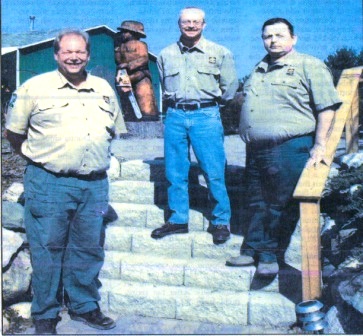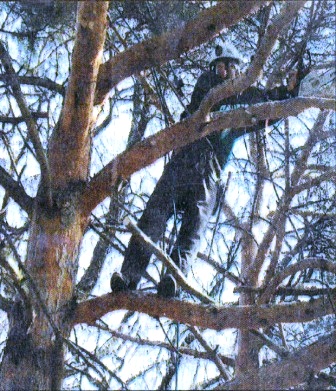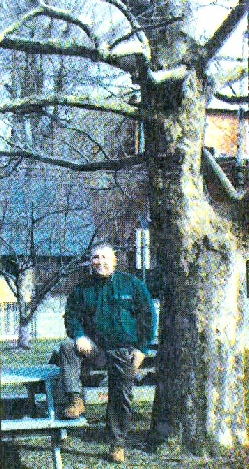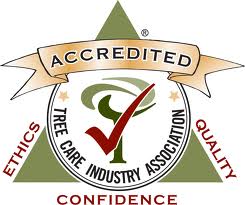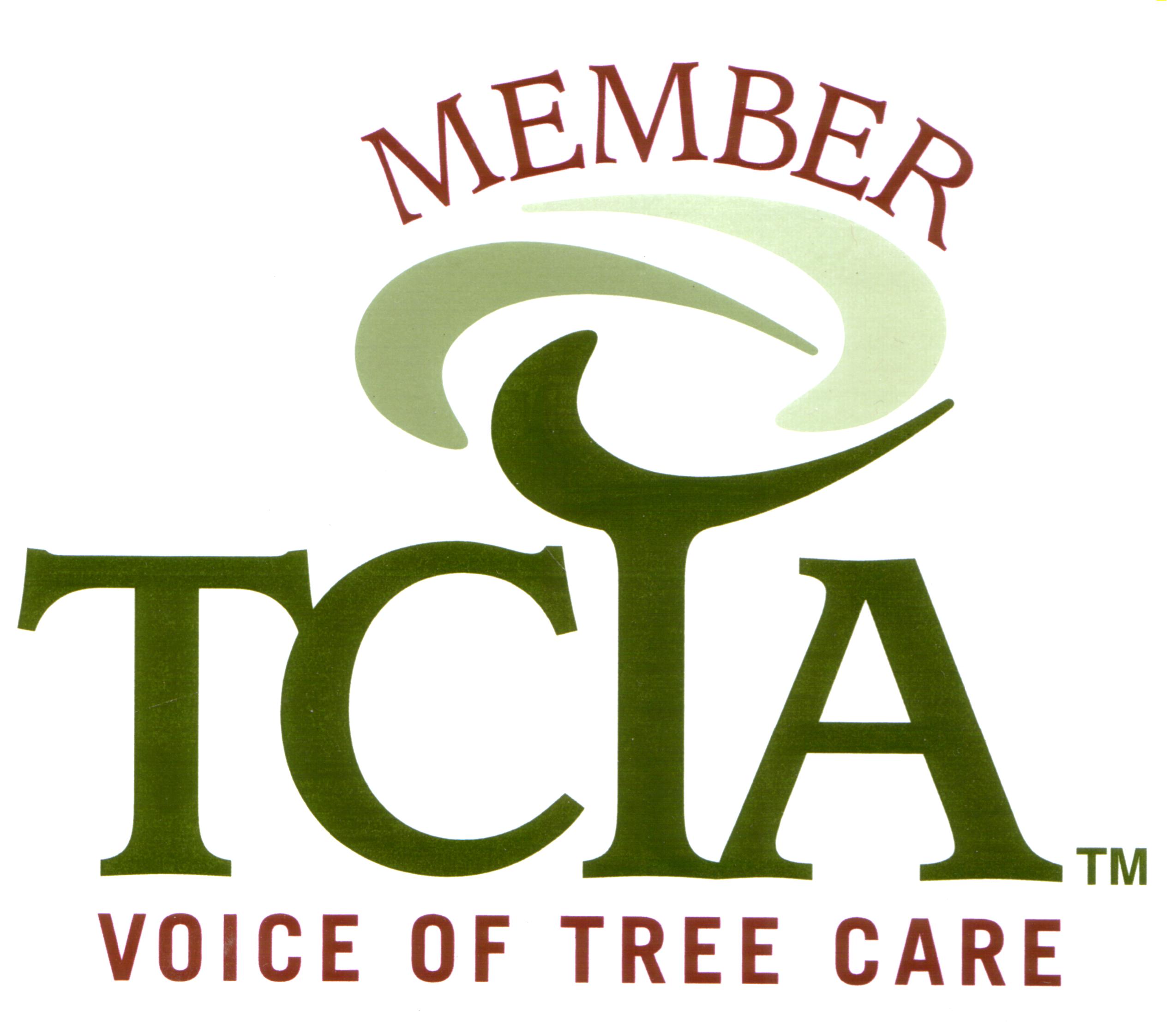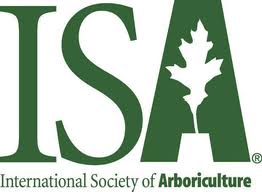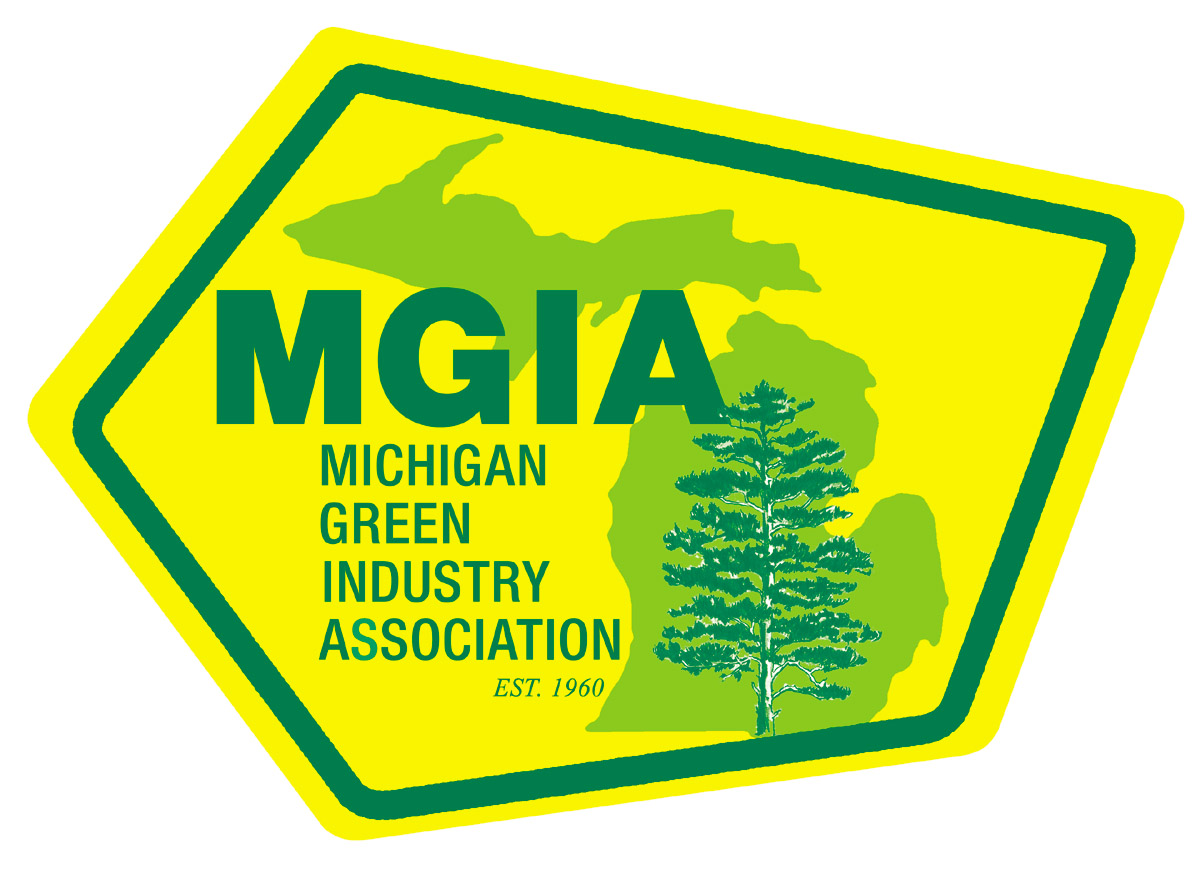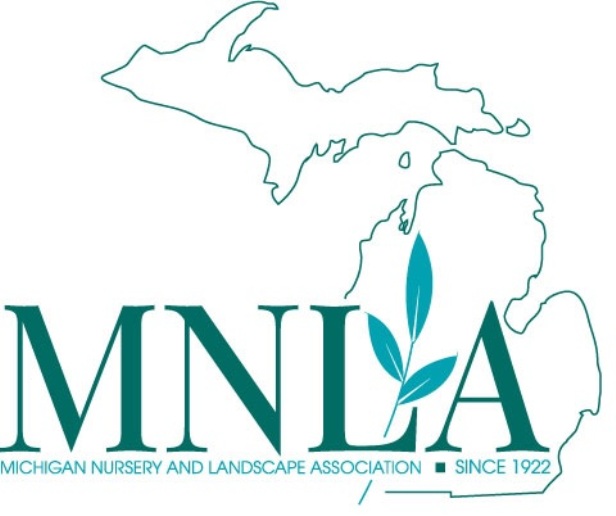IT’S TIME TO LOOK UP!
SPRING’S THE BEST TIME TO TAKE CARE OF NATURE’S ‘FINE FURNITURE’
Iris Lee Underwood
April 12, 2006
Before you fill the spreader with fertilizer and hit the turf, George Lee, arborist and owner of Branch Tree Service, recommends you look up first.
“It’s the nature of our design to look down at the lawn and gardens this time of year, not up at the trees. But if homeowners understood the impact of tree care and safety on their property and person, they could avoid a lot of damage and expense,” Lee says.
He shakes his head and tells the story about a man from Lapeer whose chest was crushed in his sleep by a diseased tree when it crashed through his house.
Regrettably, Lee hears these scenarios too often in his industry.
“It took my attention to a tree I needed to inspect on my property. With the season’s high winds, I wanted to prevent the tree from reaching the point of failure,” Lee says.
A man who has always loved the outdoors, trained under his father’s influence as an arborist, Lee is passionate about trees and his mission to educate his clients about tree health, care and safety.
Lee raises his eyebrows toward the giant sycamore in Romeo’s park downtown.
“This is a diamond in the rough. Just look at the character of that tree, even without foliage. It has tremendous artistic value year round,” he says.
Randy Owen, owner of Owen Tree Service in Attica with Tom Morgan, sales and marketing manager and Kirk Gruenwald, operations manager, are busy with spring tree care and safety.
Tree safety 101
Lee explains that basic, good tree care begins with a slow walk around the yard.
“Look at each tree as if it were like a fine piece of furniture in your home,” he suggests. “Analyze the tree, see what you like and dislike. Where is the tree’s location in relationship to the house, office, buildings or driveways? What trees are important to your property, to have around your house? What trees are in front of the house? What impact do they have on curb appeal?”
Before the trees leaf out, this is also the perfect time to inspect splits in the bark of tree, seepage of sap, and dead wood snagged on branches or fallen on the ground,. Take binoculars and look up on the top branches. Are there buds? If not, chances are the tree is in trouble.
If so, especially with larger trees, it’s time to call an arborist, “a specialist in the care and maintenance of trees.” But before you do, Lee cautions, “Study the tree. Know what service you want for your tree. Don’t give carte blanche to arborists or a tree service you’ve never met. Not all tree services are alike.”
Fortunately, Macomb and Lapeer counties boast the only two tree service businesses in Michigan that carry the TCIA (Tree Care Industry Association) accreditation. Owen Tree Service, Inc., with offices in Attica and Pontiac, was the first tree service company in Michigan awarded accreditation, and Branch Tree Service of Warren and Romeo, afterwards. This meant submitting a detailed business plan and fulfilling 84 criteria to achieve the TCIA accreditation.
“The more accreditation a company carries, the better for the consumer,” says Randy Owen, owner of his company since 1985. “The main problem in our industry is non-professional, unqualified tree services.”
And since the average person isn’t educated in general tree health, care and safety, the typical homeowner or business owner is vulnerable to unethical and sub-standard tree diagnosis and treatment.
In other words, “Buyer beware.”
“Sadly, cleanup is usually how customers rate a tree service,” Owen says. “Many of the tree services out there are not technically safe in their treatments and don’t practice proper tree pruning and tree spraying. They’ve not educated themselves or invested the time and expense to learn the industry.”
Like Lee, Owen’s “curiosity of trees” as a youth developed the arborist within his soul. He has long participated in the National Arborists Association, now known as the Tree Care Industry Association. He points to the company’s motto on the wall of the office’s conference room: “Honest, quality, professional care of trees and shrubs that our children will be proud of.”
“Those are not just words, but our philosophy, our values,” Owen says. “Safety is our culture, the company, and equal to our profitability. True arborists live a strong, cultural safety program. If a crew feels unsafe with a job at their skill level or equipment ability, they can leave if conditions are not favorable.”
George Lee of Branch Tree Service in Romeo.
Nick Bomber, of Branch Tree Service, used to sky-high heights, prunes tree in February.
An arborist’s standards
Owen Tree Service and Branch Tree Service have established tree fertilization guidelines according to the industry’s standard that reads, “Injection sites shall be evenly spaced within the fertilization area. Injection sites shall be 12 to 36 inches apart and 4 to 12 inches deep. Fertilizer shall be evenly distributed among the injections sites.”
The arborists study variables related to the health of specific trees and shrubs. Environmental changes, for instance.
“For the past eight years or so, we’ve noticed everything’s been coming out a little earlier each spring,” Kirk Gruenwald, Owen’s Plant Health Care Manager says. “There might be something to this global warming.”
He talks about a few basic health-care service guidelines: spray when the pest is hatching and follow temperature guides for spraying according to the “degree day” chart.
“For instance, certain insects appear when the lilacs bloom,” Tom Morgan, Owen Tree sales and marketing manager explains.
Arborists term this biological phenomena correlated with climatic conditions as a “phonological event”.
“Nature tells you things,” Gruenwald nods. “When the black locust blooms, the emerald ash borer emerges.”
The arborists speak in terms of responsibility, telling the truth if a tree cannot be saved because it is “too far gone”.
Occasionally, nature has surprised them, and a tree they thought hopeless survived. And they’ve witnessed the reverse.
“Although we are experts and our crews are capable, experienced arborists and applicators, we don’t know everything,” Owen says. “We’re always learning as nature changes. When I look at a tree, 300 things come to mind. The diagnosis begins as you walk around the tree and touch it.”
“Sometimes you can see signs as soon as you pull into the property,” Gruenwald adds.
The highest goal for an arborist is preventive care with periodic inspections before a tree or shrub manifests symptoms of disease or stress.
“Trees are the largest, most successful plant on earth,” Owen says. “In most cases, once disease has been diagnosed, chances are something’s been happening in the tree for quite a while, even up to 12 years.”
“They fight to live with all they have,” Morgan interjects.
How important is a tree?
“Customers need to consider their economic thresholds when it comes to saving a tree,” Lee says. “No two trees are alike, so people should be leery of a tree service that says they know everything. Just like doctors, we can’t provide guarantees that we can save a diseased or stressed tree.”
Lee compares tree health to that of the human body. “A doctor has to see the patient. We have to examine the tree and determine a diagnosis. A good tree service will charge minimal fees for valuable information and consultation with the customer,’ he says.
That knowledge could save the consumer an heirloom tree or shrub and a lot of money in the future.
Both Lee and Owen urge people to immediately analyze the “volcanoes” of mulch they’ve piled around their trees. Two to four inches is beneficial for drought, like a sponge, and lawn mower protection. Don’t smother the tree with more.
Lee says, “Double shredded hardwood mulch from Michigan is the best. One hundred percent cedar mulch comes in second.”
Arborists understand that “turf and trees are not friends” because the weed killers deter and restrict nutrients from reaching the roots. Furthermore, lawn fertilizers do not properly feed trees.
Treatments used by Owen Tree and Branch Tree Services restore the tree’s soil with custom blends formulated for their environment. Their tree care methods are based on science, such as the “deep root aeration and fertilization”.
“Listen to what your trees are saying.” Owen summarizes. “They will tell you if the soil conditions are low in nutrients, oxygen and water. Remember, 50 percent of your tree’s surface area is below ground. Neglect the roots, and the tree will fail.”
Owen talks with one of his young arborists about an exciting project, a 300 year-old Burr Oak in Clinton Township Owen Tree Service is preserving on a construction site.
“This is an exceptional story,” Owen smiles. “this is a specimen tree, a swamp white oak. We’re working on a national standard, the long-term plan for the tree’s safety and care.”
He points to an award on the wall.
“We hold ourselves to a high standard. When you plant a tree, you must be prepared to take care of it.” He grins.
Even if it’s 300 years later.
TREE SAFETY AND CARE
• Look up and study your trees for signs of stress or disease.
• Your tree may be in trouble if it isn't budding at the top.
• Remove snagged and dead tree branches and limbs.
• Inspect fallen tree branches for holes that indicate insect damage.
• 4 inches of mulch around trees is ideal.
• Arborists recommend double shredded Michigan hardwood mulch.
• Practice preventive tree safety and health: call an arborist.
CONTACT OWEN TREE AT:
● Leonard
Owen Tree Service provides tree, lawn, and landscape services to the following cities and towns:
Genesee County, Michigan:
● Burton
● Davison
● Flushing
● Goodrich
● Linden
● Otisville
● Clio
● Fenton
● Gaines
● Grand Blanc
● Montrose
● Otter Lake
● Flint
● Genesee
● Lennon
● Mt Morris
● Swartz Creek
Lapeer County, Michigan:
● Almont
● Brown City
● Columbiaville
● Imlay City
● Metamora
● Peck
● Attica
● Clifford
● Dryden
● Lapeer
● North Branch
● Sandusky
● Hadley
● Mayville
● Otter Lake
● Silverwood
Macomb County, Michigan:
● Armada
● Clinton Twp
● Grosse Pointe
● Macomb
● New Haven
● St Clair Shores
● Centerline
● Detroit
● Grosse Pointe Farms
● Ray
● Sterling Heights
● Chesterfield
● Eastpointe
● Grosse Pointe Shores
● Memphis
● Romeo
● Utica
● Clinton
● Fraser
● Grosse Pointe Woods
● Mt Clemens
● Roseville
● Warren
● Harrison Twp
● New Baltimore
● Shelby Twp
● Washington
Oakland County, Michigan:
● Auburn Hills
● Bloomfield Village
● Ferndale
● Orion
● South Lyon
● Berkley
● Clarkston
● Franklin
● Madison Heights
● Ortonville
● Southfield
● Beverly Hills
● Clawson
● Hazel Park
● Milford
● Oxford
● Troy
● Bingham Farms
● Commerce Twp
● Highland
● Novi
● Pleasant Ridge
● Walled Lake
● Birmingham
● Davisburg
● Holly
● Oak Park
● Pontiac
● Waterford
● Bloomfield
● Detroit
● Huntington Woods
● Oakland
● Rochester
● West Bloomfield
● Bloomfield Hills
● Farmington
● Lake Orion
● Oakland Twp
● Rochester Hills
● White Lake
● Farmington Hills
● Lathrup Village
● Orchard Lake
● Royal Oak
● Wixom
St. Clair County, Michigan:
● Algonac
● Casco
● East China
● Harbor Beach
● Lexington
● Peck
● Allenton
● Clay
● Emmett
● Harsens Island
● Marine City
● Port Huron
● Berlin
● Clyde
● Fair Haven
● Jeddo
● Marysville
● Richmond
● Brockway
● Columbus
● Fort Gratiot
● Kimball
● Memphis
● Sandusky
● Capac
● Cottrellville
● Goodells
● Lakeport
● North Street
● St Clair
